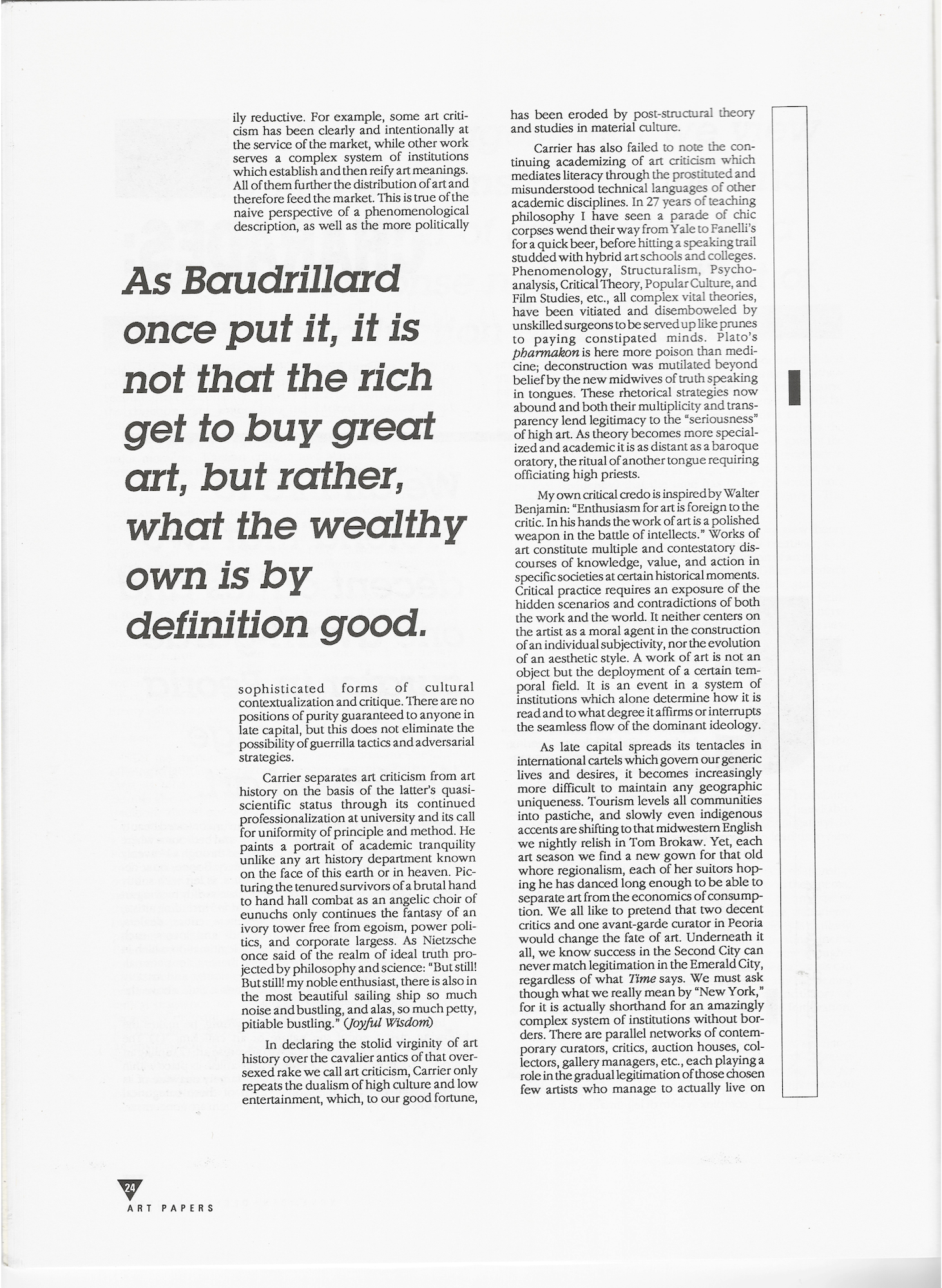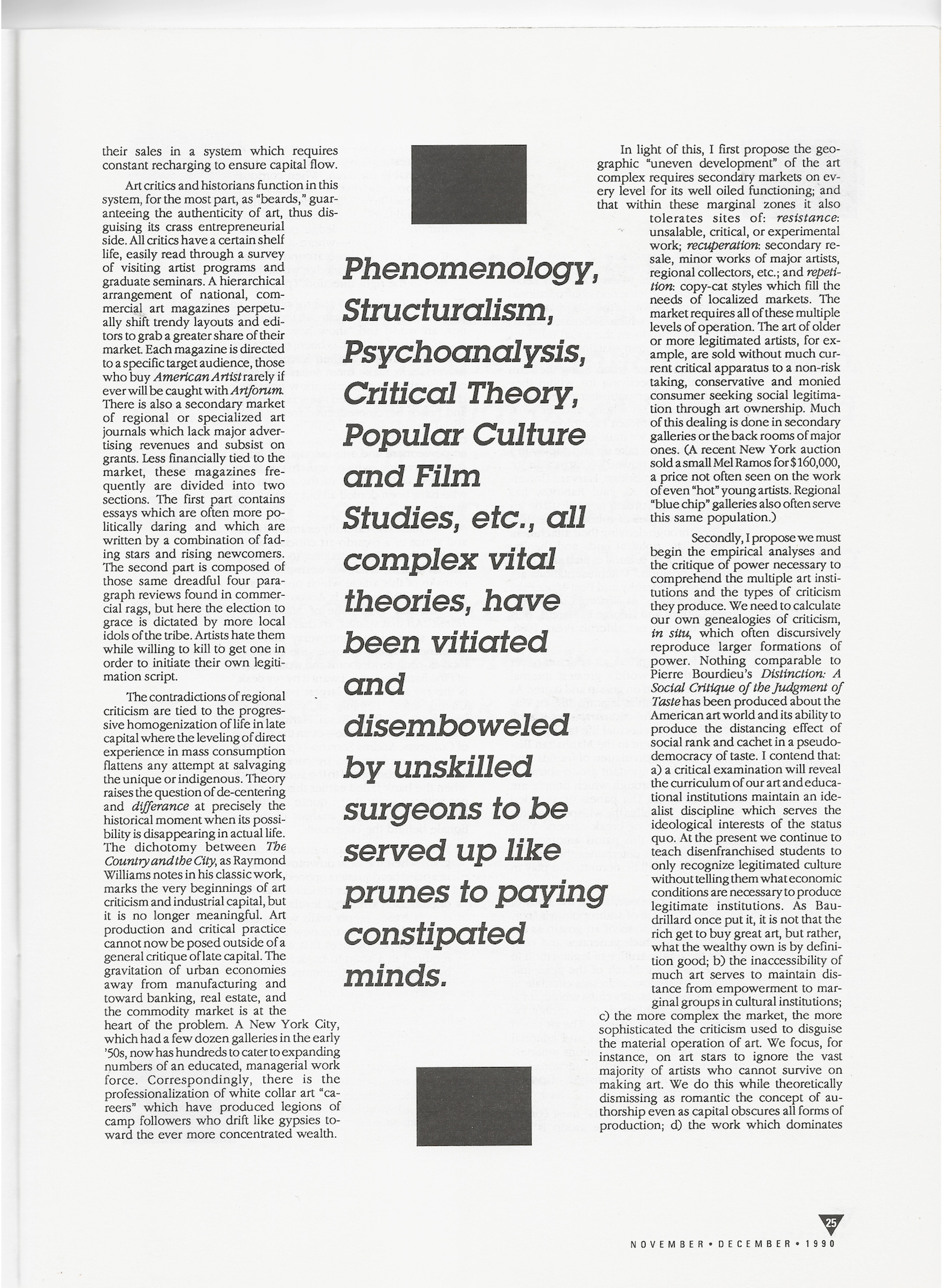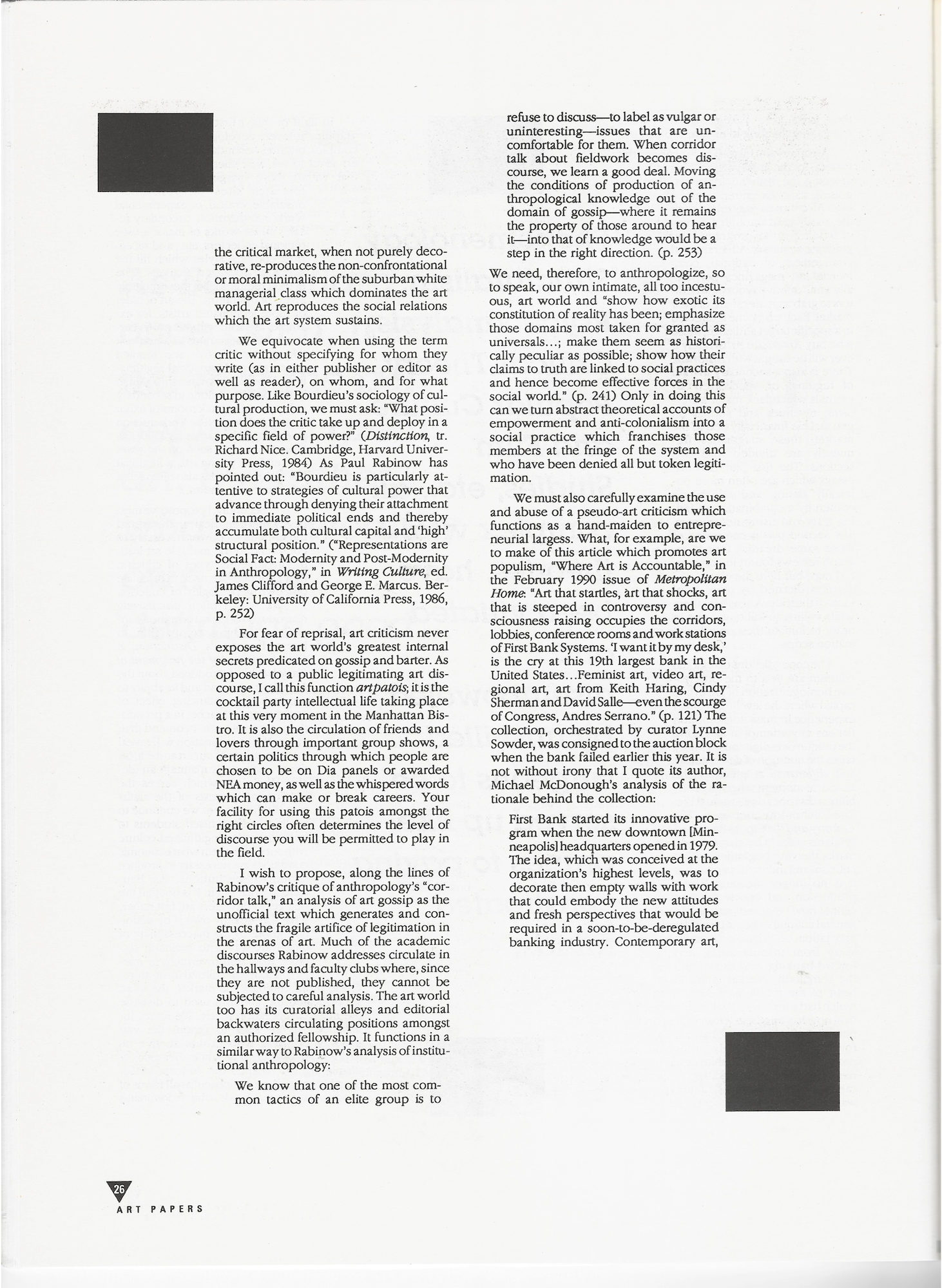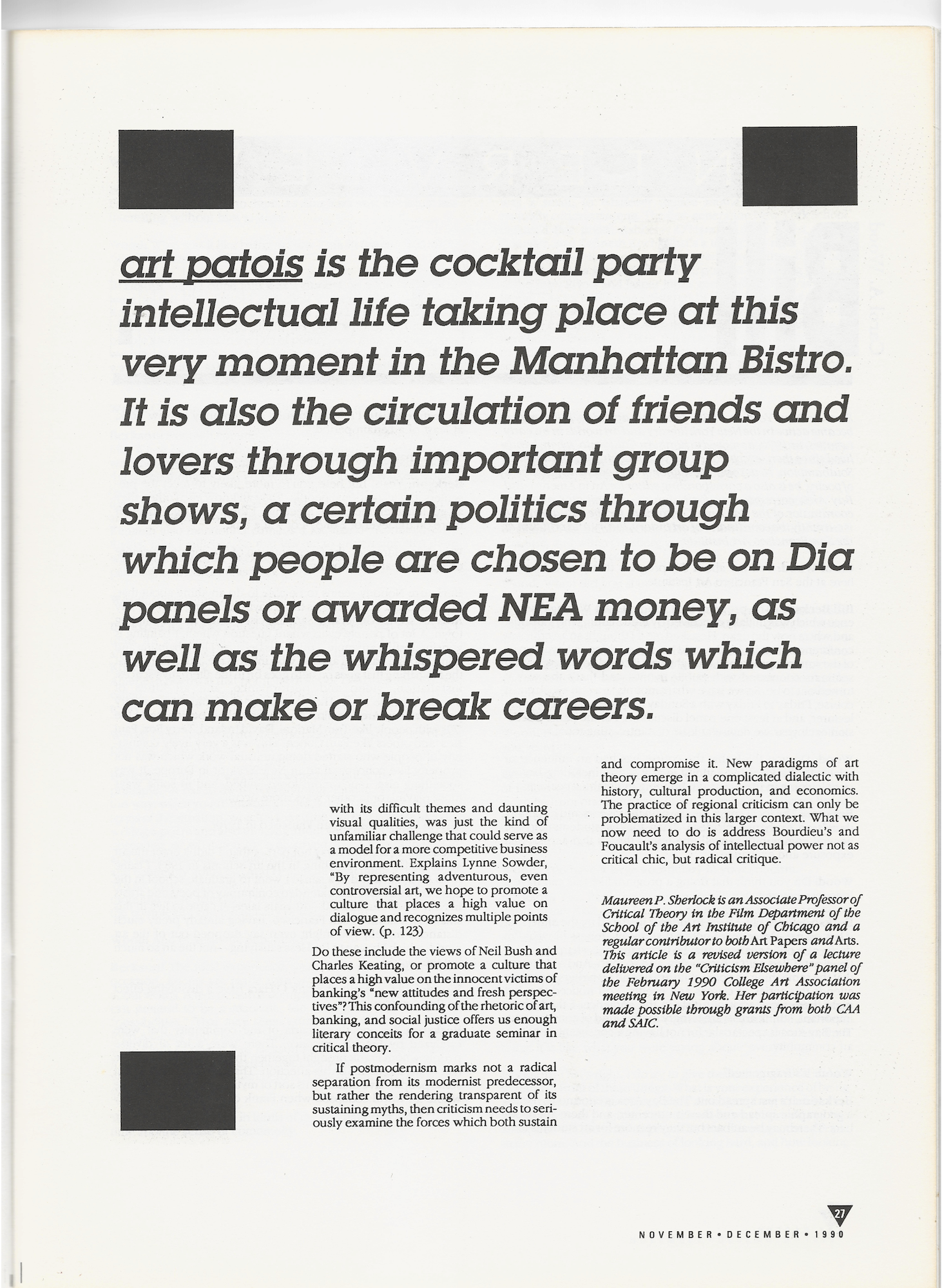Charades: A Critique of Corridor Criticism
Share:
The often tedious little melodrama of art criticism has been loath to examine its own institutional supports, while cheerily sweeping out the prestigious homes of its rival art villains. As an intellectual discipline it suffers from a series of abstractions found, to one degree or another, in all cultural institutions under late capital. While engineering key social structures to accommodate production and consumption, the demands of the economy bifurcate one’s sense of self from a shared community of values. We exist as a separated substance, both a concrete homo oeconomicus and a disconnected order of privatized social relations. At least since Kant, aesthetics has been offered as a bridge to that unitary, collective solace we are denied in the spheres of knowledge and labor. This highly bartered bridge, however, has increasingly revealed itself as just another fragmented chimera of the market.
Under these conditions, art stands as an essence in a transcendental sphere of absolute and enduring values. Some critics, like Hilton Kramer, sustain this mystique of an aesthetic judgment, founded on rather dated class criteria, long after science gave up this imaginative ghost. If in observing events I change them, according to Heisenberg, what can a free, purposeless judgment of taste presume? Criticism tends to deny the everyday construction of art territories through a complex system of legitimating institutions.
It succeeds in maintaining the charade of an uncontested beauty in the corridors, classrooms, galleries, bars, and bedrooms where mere objects are redeemed and transfigured through a heavenly discourse in the hallowed vaults of St. Mary Boone, now deceased. It is clear that criticism, like physics, is left with subtly shifting paradigms through which to articulate swiftly moving art events. There are, after all, multiple “art worlds,” including artists, viewers, media fetishizers, schools, teachers, critics, dealers, collectors, curators, and just plain friends and lovers, each seeking out and repeating other forces of legitimation which in turn legitimate them. We need to examine these various normalizing systems to understand how meaning, money, and mastery circulate in these hierarchical organizations a little above the apes, but considerably below the angels.
In David Carrier’s recent book, Artwriting, he makes the following claims about the nature of art criticism: “(1) The present-day function of artwriting is to advertise art; (2) unlike art history, art criticism has not been able to establish its place within the university; (3) this artwriting remains largely unaware of its essentially rhetorical dimensions.” Each of these categorical statements is only partially true, while all of them are unnecessarily reductive. For example, some art criticism has been clearly and intentionally at the service of the market, while other work serves a complex system of institutions which establish and then reify art meanings. All of them further the distribution of art and therefore feed the market. This is true of the naive perspective of a phenomenological description, as well as the more politically sophisticated forms of cultural contextualization and critique. There are no positions of purity guaranteed to anyone in late capital, but this does not eliminate the possibility of guerrilla tactics and adversarial strategies.
Carrier separates art criticism from art history on the basis of the latter’s quasi-scientific status through its continued professionalization at university and its call for uniformity of principle and method. He paints a portrait of academic tranquility unlike any art history department known on the face of this earth or in heaven. Picturing the tenured survivors of a brutal hand to hand hall combat as an angelic choir of eunuchs only continues the fantasy of an ivory tower free from egoism, power politics, and corporate largess. As Nietzsche once said of the realm of ideal truth projected by philosophy and science: “But still! But still! my noble enthusiast, there is also in the most beautiful sailing ship so much noise and bustling, and alas, so much petty, pitiable bustling.” (Joyful Wisdom)
In declaring the stolid virginity of art history over the cavalier antics of that oversexed rake we call art criticism, Carrier only repeats the dualism of high culture and low entertainment, which, to our good fortune, has been eroded by post-structural theory and studies in material culture.
Carrier has also failed to note the continuing academizing of art criticism which mediates literacy through the prostituted and misunderstood technical languages of other academic disciplines. In 27 years of teaching philosophy I have seen a parade of chic corpses wend their way from Yale to Fanelli’s for a quick beer, before hitting a speaking trail studded with hybrid art schools and colleges. Phenomenology, Structuralism, Psychoanalysis, Critical Theory, Popular Culture, and Film Studies, etc., all complex vital theories, have been vitiated and disemboweled by unskilled surgeons to be served up like prunes to paying constipated minds. Plato’s pharmakon is here more poison than medicine; deconstruction was mutilated beyond belief by the new midwives of truth speaking in tongues. These rhetorical strategies now abound and both their multiplicity and transparency lend legitimacy to the “seriousness” of high art. As theory becomes more specialized and academic it is as distant as a baroque oratory, the ritual of another tongue requiring officiating high priests.
My own critical credo is inspired by Walter Benjamin: “Enthusiasm for art is foreign to the critic. In his hands the work of art is a polished weapon in the battle of intellects.” Works of art constitute multiple and contestatory discourses of knowledge, value, and action in specific societies at certain historical moments. Critical practice requires an exposure of the hidden scenarios and contradictions of both the work and the world. It neither centers on the artist as a moral agent in the construction of an individual subjectivity, nor the evolution of an aesthetic style. A work of art is not an object but the deployment of a certain temporal field. It is an event in a system of institutions which alone determine how it is read and to what degree it affirms or interrupts the seamless flow of the dominant ideology.
As late capital spreads its tentacles in international cartels which govern our generic lives and desires, it becomes increasingly more difficult to maintain any geographic uniqueness. Tourism levels all communities into pastiche, and slowly even indigenous accents are shifting to that midwestern English we nightly relish in Tom Brokaw. Yet, each art season we find a new gown for that old whore regionalism, each of her suitors hoping he has danced long enough to be able to separate art from the economics of consumption. We all like to pretend that two decent critics and one avant-garde curator in Peoria would change the fate of art. Underneath it all, we know success in the Second City can never match legitimation in the Emerald City, regardless of what Time says. We must ask though what we really mean by “New York,” for it is actually shorthand for an amazingly complex system of institutions without borders. There are parallel networks of contemporary curators, critics, auction houses, collectors, gallery managers, etc., each playing a role in the gradual legitimation of those chosen few artists who manage to actually live on their sales in a system which requires constant recharging to ensure capital flow.
Art critics and historians function in this system, for the most part, as “beards,” guar- anteeing the authenticity of art, thus disguising its crass entrepreneurial side. All critics have a certain shelf life, easily read through a survey of visiting artist programs and graduate seminars. A hierarchical arrangement of national, commercial art magazines perpetually shift trendy layouts and editors to grab a greater share of their market. Each magazine is directed to a specific target audience, those who buy American Artist rarely if ever will be caught with Artforum. There is also a secondary market of regional or specialized art journals which lack major advertising revenues and subsist on grants. Less financially tied to the market, these magazines fr quently are divided into two sections. The first part contains essays which are often more politically daring and which are written by a combination of fading stars and rising newcomers. The second part is composed of those same dreadful four paragraph reviews found in commercial rags, but here the election to grace is dictated by more local idols of the tribe. Artists hate them while willing to kill to get one in order to initiate their own legitimation script.
The contradictions of regional criticism are tied to the progressive homogenization of life in late capital where the leveling of direct experience in mass consumption flattens any attempt at salvaging the unique or indigenous. Theory raises the question of de-centering and differance at precisely the historical moment when its possibility is disappearing in actual life. The dichotomy between The Country and the City, as Raymond Williams notes in his classic work, marks the very beginnings of art criticism and industrial capital, but it is no longer meaningful. Art production and critical practice cannot now be posed outside of a general critique of late capital. The gravitation of urban economies away from manufacturing and toward banking, real estate, and the commodity market is at the heart of the problem. A New York City, which had a few dozen galleries in the early ’50s, now has hundreds to cater to expanding numbers of an educated, managerial work force. Correspondingly, there is the professionalization of white collar art “careers” which have produced legions of camp followers who drift like gypsies toward the ever more concentrated wealth.
In light of this, I first propose the geographic “uneven development” of the art complex requires secondary markets on every level for its well oiled functioning; and that within these marginal zones it also tolerates sites of: resistance: unsalable, critical, or experimental work; recuperation: secondary resale, minor works of major artists, regional collectors, etc.; and repetition: copy-cat styles which fill the needs of localized markets. The market requires all of these multiple levels of operation. The art of older or more legitimated artists, for example, are sold without much current critical apparatus to a non-risk taking, conservative and monied consumer seeking social legitimation through art ownership. Much of this dealing is done in secondary galleries or the back rooms of major ones. (A recent New York auction sold a small Mel Ramos for $160,000, a price not often seen on the work of even “hot” young artists. Regional “blue chip” galleries also often serve this same population.)
Secondly, I propose we must begin the empirical analyses and the critique of power necessary to comprehend the multiple art institutions and the types of criticism they produce. We need to calculate our own genealogies of criticism, in situ, which often discursively reproduce larger formations of power. Nothing comparable to Pierre Bourdieu’s Distinction: A Social Critique of the Judgment of Taste has been produced about the American art world and its ability to produce the distancing effect of social rank and cachet in a pseudodemocracy of taste. I contend that: a) a critical examination will reveal the curriculum of our art and educational institutions maintain an idealist discipline which serves the ideological interests of the status quo. At the present we continue to teach disenfranchised students to only recognize legitimated culture without telling them what economic conditions are necessary to produce legitimate institutions. As Baudrillard once put it, it is not that the rich get to buy great art, but rather, what the wealthy own is by definition good; b) the inaccessibility of much art serves to maintain distance from empowerment to marginal groups in cultural institutions; c) the more complex the market, the more sophisticated the criticism used to disguise the material operation of art. We focus, for instance, on art stars to ignore the vast majority of artists who cannot survive on making art. We do this while theoretically dismissing as romantic the concept of authorship even as capital obscures all forms of production; d) the work which dominates the critical market, when not purely decorative, re-produces the non-confrontational or moral minimalism of the suburban white managerial class which dominates the art world. Art reproduces the social relations which the art system sustains.
We equivocate when using the term critic without specifying for whom they write (as in either publisher or editor as well as reader), on whom, and for what purpose. Like Bourdieu’s sociology of cultural production, we must ask: “What position does the critic take up and deploy in a specific field of power?” (Distinction, tr. Richard Nice. Cambridge, Harvard University Press, 1984) As Paul Rabinow has pointed out: “Bourdieu is particularly attentive to strategies of cultural power that advance through denying their attachment to immediate political ends and thereby accumulate both cultural capital and ‘high’ structural position.” (“Representations are Social Fact: Modernity and Post-Modernity in Anthropology,” in Writing Culture, ed. James Clifford and George E. Marcus. Berkeley: University of California Press, 1986, p. 252)
For fear of reprisal, art criticism never exposes the art world’s greatest internal secrets predicated on gossip and barter. As opposed to a public legitimating art discourse, I call this function art patois; it is the cocktail party intellectual life taking place at this very moment in the Manhattan Bistro. It is also the circulation of friends and lovers through important group shows, a certain politics through which people are chosen to be on Dia panels or awarded NEA money, as well as the whispered words which can make or break careers. Your facility for using this patois amongst the right circles often determines the level of discourse you will be permitted to play in the field.
I wish to propose, along the lines of Rabinow’s critique of anthropology’s “corridor talk,” an analysis of art gossip as the unofficial text which generates and constructs the fragile artifice of legitimation in the arenas of art. Much of the academic discourses Rabinow addresses circulate in the hallways and faculty clubs where, since they are not published, they cannot be subjected to careful analysis. The art world too has its curatorial alleys and editorial backwaters circulating positions amongst an authorized fellowship. It functions in a similar way to Rabinow’s analysis of institutional anthropology:
We know that one of the most common tactics of an elite group is to refuse to discuss—to label as vulgar or uninteresting—issues that are uncomfortable for them. When corridor talk about fieldwork becomes discourse, we learn a good deal. Moving the conditions of production of anthropological knowledge out of the domain of gossip—where it remains the property of those around to hear it—into that of knowledge would be a step in the right direction. (p. 253)
We need, therefore, to anthropologize, so to speak, our own intimate, all too incestuous, art world and “show how exotic its constitution of reality has been; emphasize those domains most taken for granted as universals…; make them seem as historically peculiar as possible; show how their claims to truth are linked to social practices and hence become effective forces in the social world.” (p. 241) Only in doing this can we turn abstract theoretical accounts of empowerment and anti-colonialism into a social practice which franchises those members at the fringe of the system and who have been denied all but token legitimation.
We must also carefully examine the use and abuse of a pseudo-art criticism which functions as a hand-maiden to entrepreneurial largess. What, for example, are we to make of this article which promotes art populism, “Where Art is Accountable,” in the February 1990 issue of Metropolitan Home: “Art that startles, art that shocks, art that is steeped in controversy and consciousness raising occupies the corridors, lobbies, conference rooms and work stations of First Bank Systems. ‘I want it by my desk,’ is the cry at this 19th largest bank in the United States…Feminist art, video art, re- gional art, art from Keith Haring, Cindy Sherman and David Salle-even the scourge of Congress, Andres Serrano.” (p. 121) The collection, orchestrated by curator Lynne Sowder, was consigned to the auction block when the bank failed earlier this year. It is not without irony that I quote its author, Michael McDonough’s analysis of the rationale behind the collection:
First Bank started its innovative program when the new downtown [Min- neapolis] headquarters opened in 1979. The idea, which was conceived at the organization’s highest levels, was to decorate then empty walls with work that could embody the new attitudes and fresh perspectives that would be required in a soon-to-be-deregulated banking industry. Contemporary art, with its difficult themes and daunting visual qualities, was just the kind of unfamiliar challenge that could serve as a model for a more competitive business environment. Explains Lynne Sowder, “By representing adventurous, even controversial art, we hope to promote a culture that places a high value on dialogue and recognizes multiple points of view. (p. 123)
Do these include the views of Neil Bush and Charles Keating, or promote a culture that places a high value on the innocent victims of banking’s “new attitudes and fresh perspectives”? This confounding of the rhetoric of art, banking, and social justice offers us enough literary conceits for a graduate seminar in critical theory.
If postmodernism marks not a radical separation from its modernist predecessor, but rather the rendering transparent of its sustaining myths, then criticism needs to seriously examine the forces which both sustain and compromise it. New paradigms of art theory emerge in a complicated dialectic with history, cultural production, and economics. The practice of regional criticism can only be problematized in this larger context. What we now need to do is address Bourdieu’s and Foucault’s analysis of intellectual power not as critical chic, but radical critique.
Maureen P. Sherlock was an Associate Professor of Critical Theory in the Film Department of the School of the Art Institute of Chicago and a regular contributor to both Art Papers and Arts. This article is a revised version of a lecture delivered on the “Criticism Elsewhere” panel of the February 1990 College Art Association meeting in New York. Her participation was made possible through grants from both CAA and SAIC.




